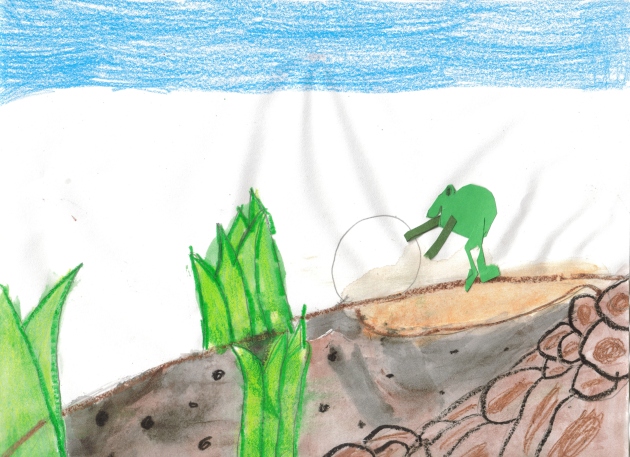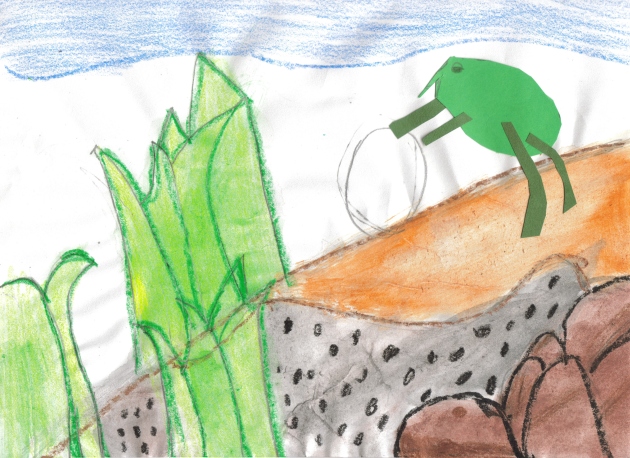The Patchwork Quilt by Valerie Flournoy, Illustrated by Jerry Pinkney, Coretta Scott King Award
Artistic media: each picture consists of a pencil, graphite, and watercolor painting, which is camera-separated and reproduced in full color. The illustrator uses thin, light lines. In our reading it said these lines demonstrate elegance and fragility. The illustrator also used circular, curved lines. These lines do give readers a feeling of safety. The blurry lines and shading makes the illustrations look like a memory. As I read the book, it reminded me of my great-grandmother and her quilts. I had forgotten about all the times I sat beside her watching her sew patches together to make a quilt, until I read this book. The grandmother also sat beside a window and sewed just like my great-grandmother did, using the light from outside. Most of the illustration backgrounds are a warm color instead of a harsh bright white. I think this helps make readers remember an old memory. The font looks as if it is Times New Romans. It is a basic font. I believe this is a great choice because the book would be too busy if the font was bold or decorative.
Interplay of Textual and Visual Images: There is a pattern in the writing and illustrations of the book. There is double page spread on the first page. When you turn the page there is a single page spread. When you turn again, there is a double page spread. This pattern is throughout the book. The background is more of the focus on the double page spread. For example, the reader’s eyes focus on the details of the kitchen. There are pots, pans, cutting board, rolling pin, and a pan of biscuits. When the reader turns the page to the single page spread, the focus is more on the characters and the small details. The little girl is sitting in the chair with her Grandma. You can see her sewing tools and how the scrap quilt scraps piece together. The reader’s eyes also focus more on the facial expressions of the characters.
Themes: A reoccurring theme throughout the book is that Tanya admires her Grandmother’s ability to quilt. Each picture shows Tanya helping her Grandmother with the quilt. The Grandma also takes scraps of something special from each family member. She takes a piece from her brother’s jeans, Tanya’s Halloween costume, gold material from her Mother’s dress, and a piece of Grandma’s quilt. At the end of the story the Grandma gets well and the masterpiece is a family quilt.
Experience of the Author and Illustrator: The African American culture is represented in this book because of its illustrations of African American characters. The author, Valerie Flourney, and illustrator, Jerry Pinkney, are both African American. It is interesting that it is an African American family because the love and family ties evident in this book would fit any race and culture. If I read the story aloud to children and did not show the illustrations, they would probably not be able to predict was race this family was. Many of them would probably visualize their own family, Caucasian, Hispanic or African American.
I would use this book to go along with a personal narrative mini lesson. I automatically thought about my great Grandma when reading this book and was able to make a personal connection. As a result, I could model to students how a book makes you remember something or someone in your life that you can write about. Then I could model my own writing in front of the kids. This might help students learn how to pick out a topic. They can think of a book we have read and then think about what it reminds them of.
Officer Buckle and Gloria Written and Illustrated by Peggy Rathmann Caldecott Award Winner
Artistic Media: She used watercolor and ink to create the cartoon style illustrations. She uses thick bold lines to outline objects and as a frame for most of the illustrations and a white background. She also uses many diagonal lines to show movement. The first page is a double page spread. The swivel chair contains diagonal lines to show that the chair fell. Officer Buckle is also drawn with diagonal lines in the same direction to show how the motion of him falling. The post it notes have diagonal line to show them blowing. The author and illustrator also used bright colors that would catch and hold the attention of younger readers. She also uses page turns to capture suspense. In the first page Office Buckle is flying in the air after he fell out of the chair. This makes the reader want to turn the page to see if he falls on the ground or what is going to happen next. In another picture, Mrs. Toppel is standing in a swivel chair. Again this makes readers turn the page to see what will happen next.
Interplay of Textual and Visual Images: The illustrations capture the humor in the story and without them, the text would be bland. The text alone would not hold the readers’ attention. The illustrations make the classroom roar with laughter. On one page, Officer Buckle is shocked at how the kids are clapping and cheering during his speech. The picture shows Gloria acting like she is dead and flopping around while he talks. The reader can infer that the kids are clapping and cheering for Gloria, not Officer Buckle.
Themes: The first reoccurring theme in this book is safety. The bright yellow end papers contain stars with safety rules on them. Some are rules that we usually reinforce to children such as do not play with matches, wash your hands after you use the toilet. Others are rules that some children might not have heard of before such as never eat mayonnaise that’s been sitting in the sun or never bother a big dog while it’s eating. At the end of the story, readers learn the other theme in this book. If you are working with a partner or group, it is better to work together. When Office Buckle gave speeches by himself, children fell asleep and thought it was boring. When Gloria stood at the front by herself, the children and Gloria fell asleep. But when the two worked together, their speech was effective and exciting!
Experience of the Author and Illustrator: I searched for information about the author and illustrator, Peggy Rathmann. On her personal website, Rathmann stated that the idea of the book came from a home video of her mother and dog. Her mother was talking in the dining room while the dog licked every poached egg on the buffet. The next scene shows the whole family at the table telling her mother how delicious the eggs were. She has studied commercial and fine art. She has also studied children’s book writing and illustrating.
I would read this book to students towards the beginning of the year when we are establishing a classroom environmen and learning about community helpers. In the past I have read this to tie in community helpers but after deeply reading the story and analyzing it, it would fit better with why it is important to work together in a group. They were able to work more effectively when they worked together, instead of one person doing it alone.
Source: http://www.peggyrathmann.com/peggyrathmann.html
Moses: When Harriet Tubman Led Her People to Freedom
Artistic Technique/Media: The illustrations were created by oil paintings. The paintings show the intensity in the characters’ emotions. The illustrations automatically make the reader feel as if they were escaping along with Harriet. The colors used in the paintings are mostly dark ,bold, and rich. Most of the illustrations are dark and it is very hard to see the parts of the painting. This aligns with the fact that slaves had to escape during the night so they would not be seen. The illustrations are on double pages and the text fits perfectly on the page. Without the illustrations, readers would not experience the intensity of the story and its meanings. Along with intense and beautiful illustrations, this book is interesting because there are three different sets of text. The first text seems to be typed in Times New Roman font. This represents the narrator of the story. The next text is typed in italics and represents Harriet’s thoughts and her conversations with God. The third text is written in all capital letters in more of a faint color than the rest of the text. I love how the text in this book is written. It easily shows the readers that there are three main speakers in this book with God being the most important. This text is usually written in a flowing manner to show he is all around us. It is also written in a circle surrounding her, signifying he has wrapped himself around her in protection.
Interplay of Textual and Visual Images: The text alone tells a story and would hold the reader’s attention; the illustrations enhance the beauty of this book. The author creates tension by describing how Harriet hears hoof beats and she goes to sleep praying God will help her. The reader learns that the horses passed so they turn the page to find out what will happen next on her journey.
Themes: Throughout the book the author depicts devotion to God. Harriet put all of her worries about escaping and being caught to God and he helped her. There were times she questioned whether or not he was still there to protect her, but he was.
Examine the Experience of the Author and Illustrator: The author, Carole Boston Weatherford has written many books dealing with rights issues such as: Birmingham, 1963 and Freedom on the Menu: The Greensboro Sit-Ins. She has received numerous awards for her books and poetry; including the North Carolina Award for Literature, the state’s highest civilian honor. She also lived in the same county where Harriet Tubman was born. The illustrator, Kadir Nelson is an African American whose paintings are mostly of influential African Americans. His oil paintings are very intense and show details of emotions.
I would probably read this particular book when teaching about Black History Month. I do not know how well my first grade students would follow the three speaking text in this book. I also do not think they would fully appreciate the meaning of this book because they do not understand the struggles and fear of slavery and the escape.
Sources: http://cbweatherford.com/about/ http://www.kadirnelson.com/Artist-Biography.html

